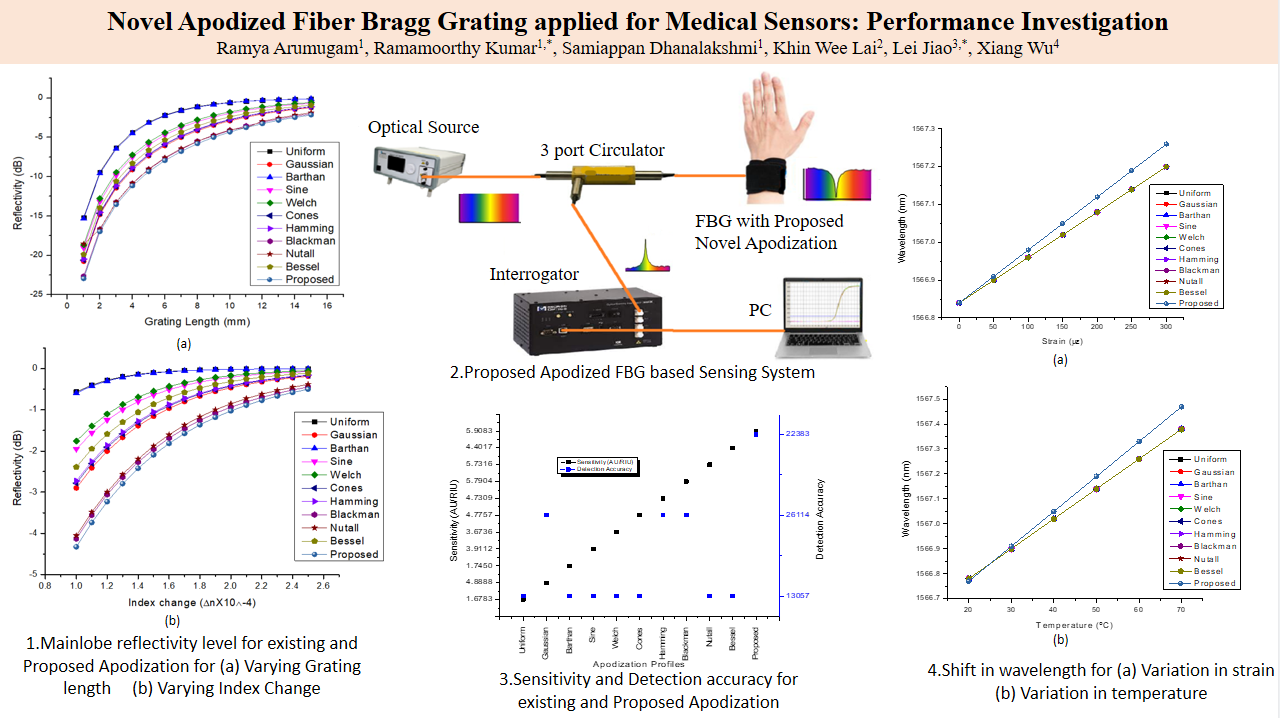 Open Access
Open Access
ARTICLE
Novel Apodized Fiber Bragg Grating Applied for Medical Sensors: Performance Investigation
1 Department of Electronics and Communication Engineering, College of Engineering and Technology, SRM Institute of Science and Technology, Kattankulathur, Chengalpattu, 603203, India
2 Department of Biomedical Engineering, Faculty of Engineering, Universiti Malaya, Kuala Lumpur, 50603, Malaysia
3 General Hospital of Xuzhou Mining Group, Xuzhou, 221000, China
4 School of Medical Information & Engineering, Xuzhou Medical University, Xuzhou, 221000, China
* Corresponding Authors: Ramamoorthy Kumar. Email: ; Lei Jiao. Email:
(This article belongs to the Special Issue: Enabled and Human-centric Computational Intelligence Solutions for Visual Understanding and Application)
Computer Modeling in Engineering & Sciences 2023, 135(1), 301-323. https://doi.org/10.32604/cmes.2022.022144
Received 22 February 2022; Accepted 24 May 2022; Issue published 29 September 2022
Abstract
Sensors play an important role in shaping and monitoring human health. Exploration of methods to use Fiber Bragg Grating (FBG) with enhanced sensitivity has attracted great interest in the field of medical research. In this paper, a novel apodization function is proposed and performance evaluation and optimization of the same have been made. A comparison was conducted between various existing apodization functions and the proposed one based on optical characteristics and sensor parameters. The results evince the implementation of the proposed apodization function for vital sign measurement. The optical characteristics considered for evaluation are Peak Resonance Reflectivity level, Side Lobes Reflectivity level and Full Width Half Maximum (FWHM). The proposed novel apodization novel function has better FWHM, which is narrower than the FWHM of uniform FBG. Sensor characteristics like a quality parameter, detection accuracy and sensitivity also show improvement. The proposed novel apodization function is demonstrated to have a better shift in wavelength in terms of temperature and pulse measurement than the existing functions. The sensitivity of the proposed apodized function is enhanced with a Poly-dimethylsiloxane coating of varying thickness, which is 6 times and 5.14 times greater than uniform Fiber Bragg grating and FBG with the proposed novel apodization function, respectively, enhancing its utilization in the field of medicine.Graphic Abstract

Keywords
Cite This Article
 Copyright © 2023 The Author(s). Published by Tech Science Press.
Copyright © 2023 The Author(s). Published by Tech Science Press.This work is licensed under a Creative Commons Attribution 4.0 International License , which permits unrestricted use, distribution, and reproduction in any medium, provided the original work is properly cited.


 Submit a Paper
Submit a Paper Propose a Special lssue
Propose a Special lssue View Full Text
View Full Text Download PDF
Download PDF Downloads
Downloads
 Citation Tools
Citation Tools